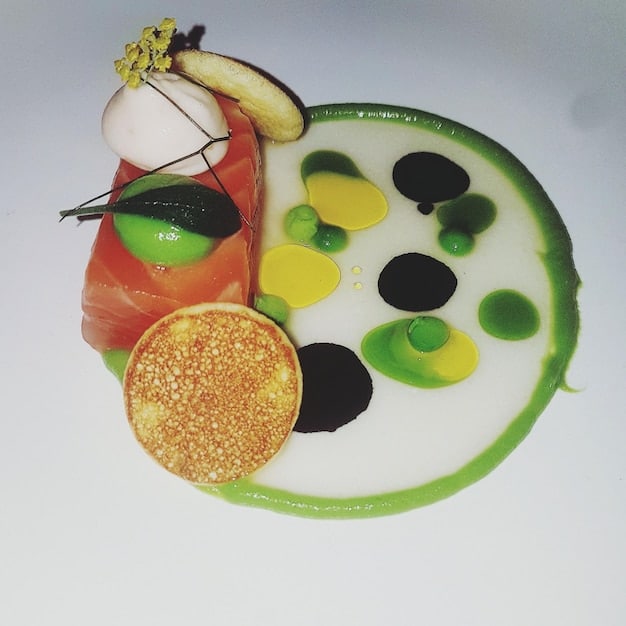The Next Big Thing: Predicting Culinary Trends in America

The next big trend in American culinary arts is likely to be a fusion of technology, sustainability, and personalization, with an increasing focus on plant-based options, innovative cooking techniques, and immersive dining experiences.
American culinary arts are constantly evolving, shaped by cultural shifts, technological advancements, and changing consumer preferences. So, what’s the next big trend in American culinary arts? Let’s dive into the predictions and innovations that are poised to redefine the American dining experience.
Culinary Technology and Innovation
Technology is rapidly transforming the culinary landscape, from precision cooking to AI-driven menu planning. Let’s explore some of the tech-driven innovations that are set to become mainstream.
Robotics in the Kitchen
Robotics and automation are making their way into commercial kitchens, streamlining food preparation and enhancing efficiency. These technologies can handle repetitive tasks, ensuring consistency and reducing labor costs.
3D Food Printing
3D food printing is another emerging technology that could revolutionize how food is prepared and presented. By allowing chefs to create intricate designs and personalized nutrition profiles, 3D printing opens up new possibilities for culinary creativity and customization.
- Personalized Nutrition: Tailoring meals to individual dietary needs and preferences using 3D printing technology.
- Sustainable Food Production: Utilizing alternative ingredients and reducing food waste with precise printing processes.
- Innovative Meal Designs: Creating visually stunning dishes that were previously impossible with traditional cooking methods.
These technological advancements are not just about efficiency; they also offer opportunities to improve the dining experience and address sustainability concerns.

The integration of technology into culinary arts promises to enhance both the creative and operational aspects of the industry, paving the way for more innovative and efficient food production.
The Rise of Plant-Based Cuisine
Plant-based foods are no longer a niche market but a mainstream culinary trend, driven by health, environmental, and ethical concerns. Let’s delve into the growing popularity of plant-based cuisine and its impact on American dining.
Beyond Meat Alternatives
While plant-based meat alternatives like Beyond Meat and Impossible Foods have gained significant traction, chefs are also exploring new and creative ways to showcase vegetables, legumes, and grains. This involves using innovative cooking techniques and flavor combinations to create dishes that are both delicious and nutritious.
Vegan Fine Dining
Vegan fine dining is another area where plant-based cuisine is making significant strides. High-end restaurants are now offering elaborate vegan tasting menus that rival their traditional counterparts, demonstrating the versatility and sophistication of plant-based ingredients.
- Innovative Ingredient Use: Employing lesser-known vegetables and plant-based proteins to create unique and exciting dishes.
- Creative Flavor Profiles: Developing complex flavor combinations that highlight the natural tastes of plant-based ingredients.
- Sustainable Sourcing: Prioritizing locally sourced and sustainable ingredients to minimize environmental impact.
The rise of plant-based cuisine reflects a broader societal shift towards healthier and more sustainable eating habits, influencing menus and culinary practices across the country.
Plant based options are becoming more and more popular even outside of vegan restaurants. Many non-vegan restaurants are adding new vegan options to cater to popular demand of plant based food.
Sustainability and Ethical Sourcing
Sustainability is becoming a core value in the culinary world, influencing everything from ingredient sourcing to waste management. Here’s how sustainability is shaping the future of American culinary arts.
Farm-to-Table Initiatives
Farm-to-table initiatives connect restaurants directly with local farmers, ensuring fresh, seasonal ingredients and supporting local economies. These initiatives also promote transparency and traceability in the food supply chain.
Reducing Food Waste
Food waste is a major environmental and economic issue, and chefs are increasingly focused on reducing waste through creative menu planning and innovative preservation techniques. This includes using scraps and leftovers to create new dishes and implementing composting programs.

Chefs are increasingly focused on reducing waste through creative menu planning and innovative preservation techniques.
- Waste Reduction Strategies: Implementing composting programs and utilizing food scraps in creative ways.
- Ethical Sourcing Practices: Prioritizing fair trade and sustainable farming methods.
- Seasonal Menus: Designing menus around seasonal ingredients to minimize transportation and support local farmers.
Sustainability is not just a trend; it’s a fundamental shift in how chefs and consumers view food, driving innovation and responsibility in the culinary industry.
Ethical sourcing and sustainability are more than just trends, they are becoming expectations for consumers.
Personalized Dining Experiences
Personalization is transforming the dining scene, with restaurants offering customized menus and experiences tailored to individual preferences. Let’s explore how personalization is reshaping the future of American culinary arts.
Customizable Menus
Restaurants are increasingly offering customizable menus that allow diners to create their own dishes based on their dietary needs and preferences. This includes options for adjusting portion sizes, ingredient substitutions, and spice levels.
Interactive Dining
Interactive dining experiences, such as tableside presentations and chef’s tasting menus, are also gaining popularity. These experiences provide diners with a more engaging and personalized culinary journey.
These experiences provide diners with a more engaging and personalized culinary journey.
- Dietary Customization: Tailoring dishes to accommodate allergies, intolerances, and dietary restrictions.
- Interactive Elements: Incorporating elements like tableside cooking and personalized recommendations.
- Data-Driven Insights: Utilizing data to understand customer preferences and improve menu offerings.
Personalization enhances customer satisfaction and loyalty, making it a key trend in the competitive culinary landscape.
Restaurants that embrace personalization are more likely to attract and retain customers in today’s dynamic market.
The Influence of Global Flavors
Global flavors continue to influence American cuisine, with chefs drawing inspiration from diverse culinary traditions around the world. Let’s examine how global flavors will shape the next big culinary trends in the US.
Authentic Regional Cuisine
Instead of simply incorporating generic “ethnic” flavors, chefs are now focusing on authentic regional cuisines, showcasing the unique ingredients and techniques of specific regions. This includes dishes from lesser-known areas of Asia, Africa, and South America.
Fusion with American Classics
Fusion cuisine is also evolving, with chefs creatively blending global flavors with American classics. This approach allows for innovative and exciting dishes that appeal to a wide range of palates.
This approach allows for innovative and exciting dishes that appeal to a wide range of palates.
- Authenticity in Ingredients: Sourcing traditional ingredients to maintain the integrity of global flavors.
- Cultural Immersion: Educating diners about the origins and stories behind the dishes.
- Creative Blending: Combining global flavors with American classics for unique culinary experiences.
Global flavors enrich the American dining scene, making it more diverse and exciting for both chefs and consumers.
Chefs are embracing diversity and experimentation, reflecting the increasingly globalized nature of American society.
Hyperlocal and Foraged Ingredients
The trend of using hyperlocal and foraged ingredients is gaining momentum, as chefs seek to connect diners with the unique flavors of their local environments. Let’s explore the growing interest in hyperlocal and foraged foods.
Urban Farming
Urban farming initiatives, such as rooftop gardens and vertical farms, are bringing fresh produce directly to urban restaurants. This reduces transportation costs and environmental impact while providing chefs with access to unique and seasonal ingredients.
Wild Foraging
Wild foraging involves gathering edible plants and mushrooms from natural environments. Chefs are partnering with experienced foragers to source unique and flavorful ingredients that cannot be found in traditional markets.
Chefs are partnering with experienced foragers to source unique and flavorful ingredients that cannot be found in traditional markets.
- Local Sourcing: Prioritizing ingredients sourced within a specific geographic area.
- Seasonal Availability: Designing menus around the seasonal availability of hyperlocal ingredients.
- Unique Flavors: Showcasing the distinctive tastes and textures of foraged foods.
Hyperlocal and foraged ingredients offer diners a unique and authentic taste of place, enhancing the overall dining experience.
This trend celebrates the unique flavors of local environments and promotes a deeper connection between food and place.
| Key Trend | Brief Description |
|---|---|
| 🤖 Culinary Technology | Use of robotics and AI in food preparation and menu planning. |
| 🌱 Plant-Based Cuisine | Increasing demand for vegan and vegetarian options in fine dining. |
| 🌎 Sustainability | Ethical sourcing, waste reduction, and farm-to-table practices. |
| 🍽️ Personalized Dining | Customizable menus and interactive dining experiences. |
Frequently Asked Questions
▼
Health concerns, environmental awareness, and ethical considerations are key factors driving the popularity of plant-based options in American culinary arts. Many consumers are looking to reduce their meat consumption for these reasons.
▼
Technology is influencing everything from food preparation to menu planning, with innovations like robotics, 3D food printing, and AI-driven personalization enhancing efficiency and customization in the dining experience.
▼
Sustainability addresses environmental and economic concerns, promoting responsible sourcing, waste reduction, and ethical practices. It connects chefs with local farmers and encourages transparency in the food supply chain.
▼
Personalized dining includes customizable menus that cater to dietary needs, portion preferences, and interactive elements like tableside cooking and personalized recommendations, enhancing customer satisfaction.
▼
Global flavors bring diversity and innovation to American cuisine, with chefs drawing inspiration from authentic regional dishes and creatively fusing them with American classics to appeal to various palates.
Conclusion
The future of American culinary arts is set to be a dynamic blend of technology, sustainability, personalization, and global influence. As chefs and consumers embrace these trends, the dining experience will continue to evolve, offering innovative, ethical, and truly unique culinary adventures.





